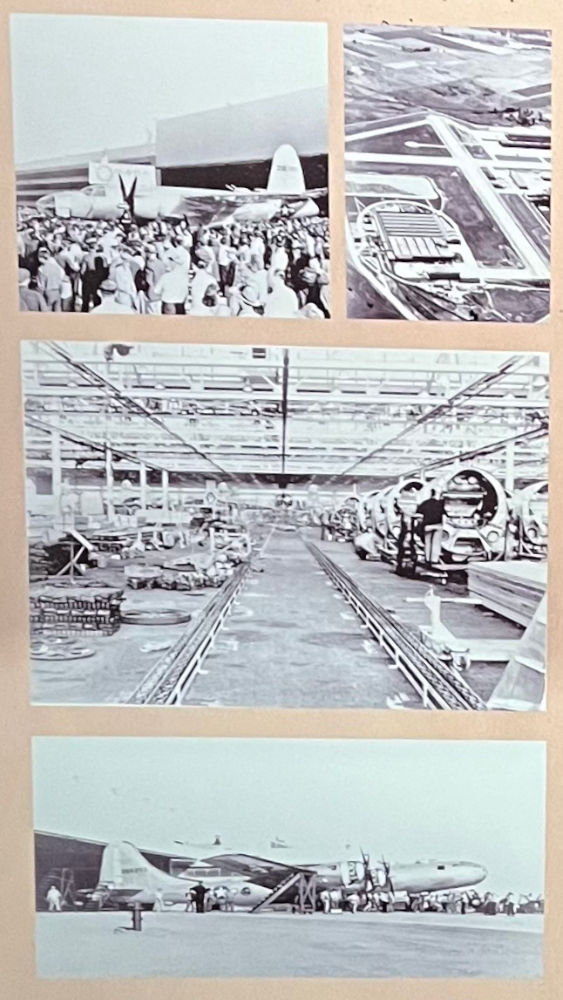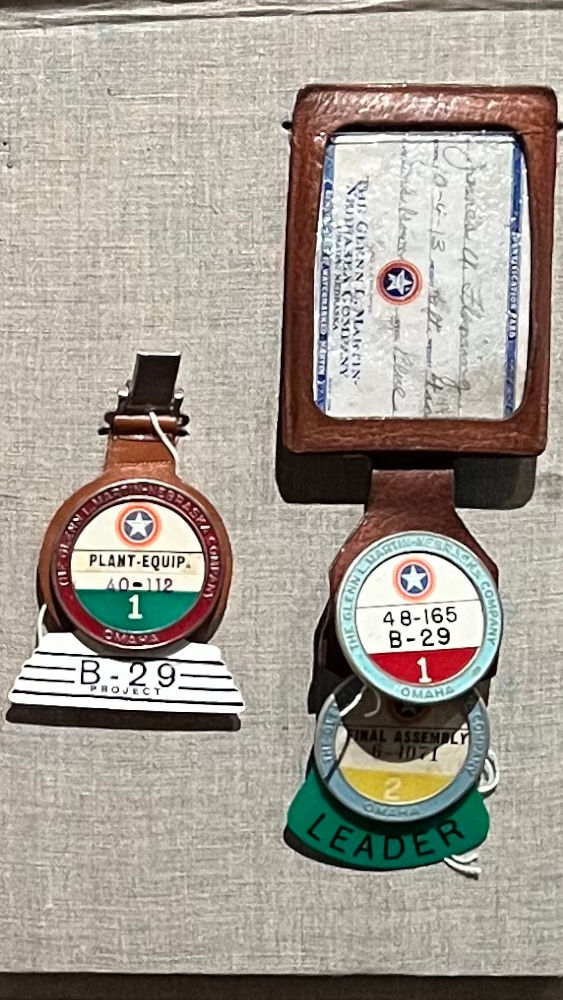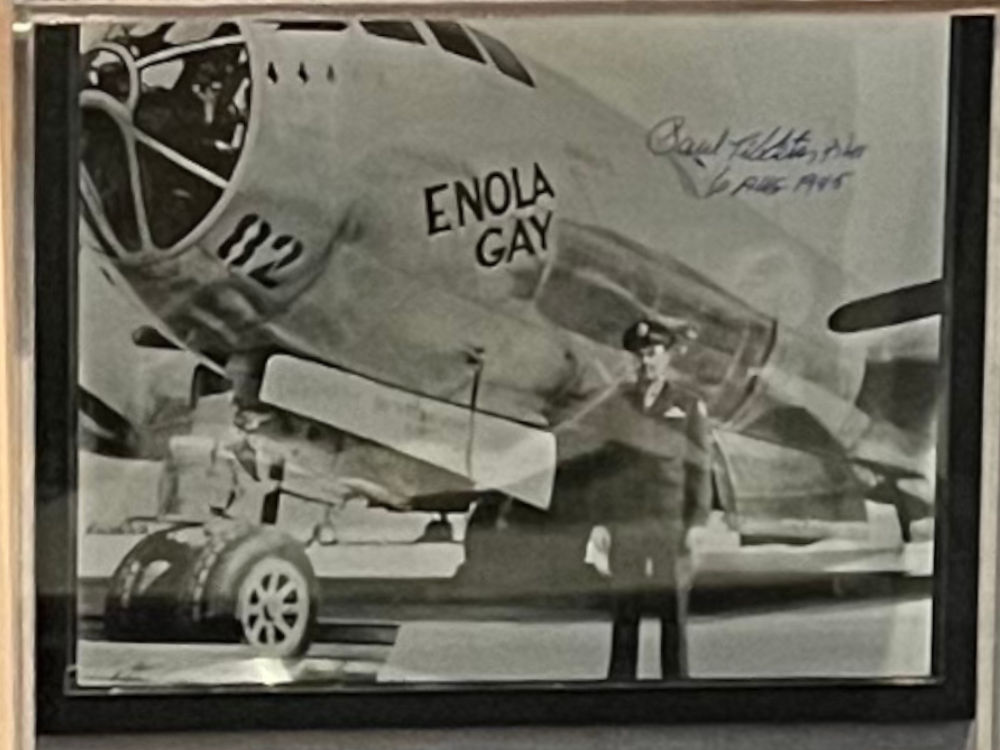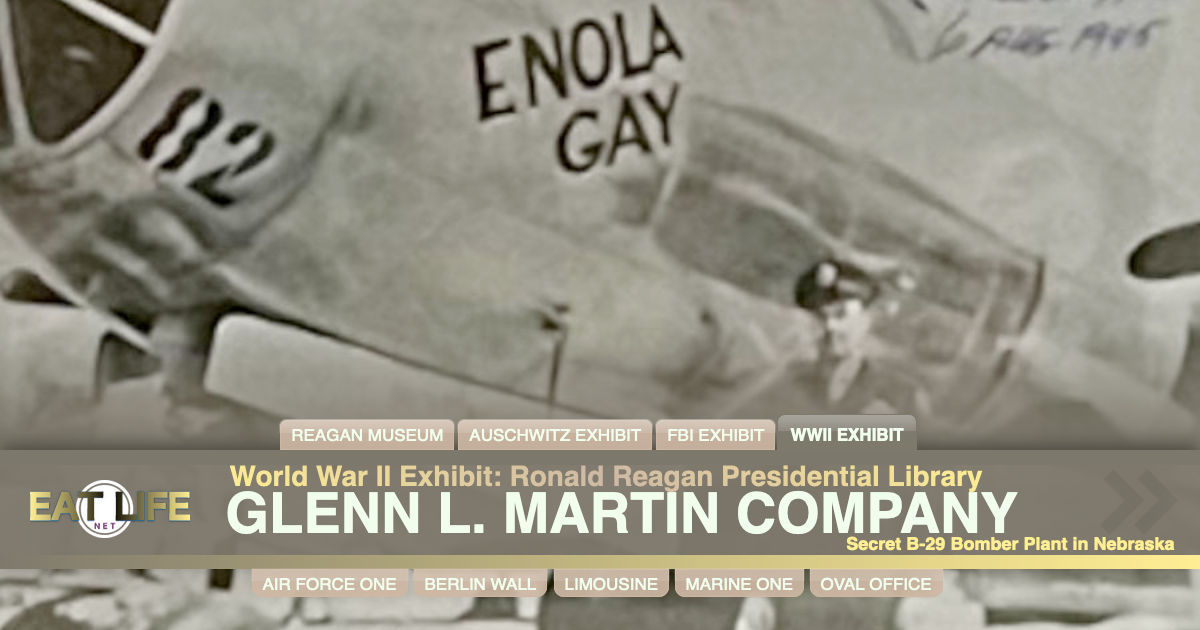They built thousands of bombers. They built the aircraft that dropped the nuclear weapons over Japan. At its peak, there were over 13,000 employees, it was the size of a small city. The plant had an aircraft assembly building, six hangers and a two-mile long runway. Nebraska is near the center of the continental United States which made it difficult for aerial surveillance by enemy forces. It was an ideal place to manufacture airplanes.
Now Lockheed Martin
Glenn L. Martin Company merged with American Marietta in 1961 then Martin Marietta merged with Lockheed in 1994.

A Secret in the Heartland
In 1940, the War Department ordered four new aircraft assembly plants. The Glenn L. Martin Company built one of these plants at Fort Crook (now Offutt Air Force Base) near Bellevue, NE, which was operational from 1942 to 1945. At its peak, there were over 13,000 employees, the size of a small city, and it had its own switchboard system, police, school, post office, library, and hotel. They even had their own beauty pageant, won by nineteen-year-old Virginia Johnson.
There were over 5300 women (making up nearly 40% of the workforce) and 760 African Americans employed there. Everyone was fingerprinted and photographed, and given an identification card that had a series of numbers and colored discs which indicated their shift and what areas they were allowed to access. The plant had the aircraft assembly building, six hangers; and a two-mile long runway. The Glenn L. Martin - Nebraska Bomber Plant primarily built heavy bombers, including the B-26C (Martin Marauder) and B-29 (Boeing Superfortress). They built over 1500 B-26s, and by 1944, they were building more than fifty B-29s a month.
 But the nondescript Aircraft Manufacturing and Assembly Building, simply known as Building "D" or Facility 301, was no ordinary building.
Fifteen planes were constructed there for the 509th Composite Group.
They were covertly altered in one of the modification centers for a top-secret mission, done according to the specifications of their crews.
Two of the planes would later be named Enola Gay and Bockscar: the aircraft that dropped the nuclear weapons over Japan.
Paul Tibbets, the pilot of the Enola Gay, personally selected his B-29-45-MO from the assembly line, serial number 44-86292, later calling it one of the best ones ever produced.
Tibbets also brought a model of the atomic bomb with him for installation tests when they were making the modifications.
Besides having acres of open land on which to build, Nebraska is near the center of the continental United States, making it difficult for aerial surveillance by enemy forces, so it was an ideal place to prepare the planes for the historic mission.
The last B-29 was finished September 18, 1945, and the plant closed on April 1, 1946.
Offutt is now the headquarters for the Strategic Air Command.
But the nondescript Aircraft Manufacturing and Assembly Building, simply known as Building "D" or Facility 301, was no ordinary building.
Fifteen planes were constructed there for the 509th Composite Group.
They were covertly altered in one of the modification centers for a top-secret mission, done according to the specifications of their crews.
Two of the planes would later be named Enola Gay and Bockscar: the aircraft that dropped the nuclear weapons over Japan.
Paul Tibbets, the pilot of the Enola Gay, personally selected his B-29-45-MO from the assembly line, serial number 44-86292, later calling it one of the best ones ever produced.
Tibbets also brought a model of the atomic bomb with him for installation tests when they were making the modifications.
Besides having acres of open land on which to build, Nebraska is near the center of the continental United States, making it difficult for aerial surveillance by enemy forces, so it was an ideal place to prepare the planes for the historic mission.
The last B-29 was finished September 18, 1945, and the plant closed on April 1, 1946.
Offutt is now the headquarters for the Strategic Air Command.

1942-1945

Excellence in War Production


August 9, 1945
Paul Tibbets was the Pilot of the Enola Gay

1942 - 1945
On August 6, 1945, the Enola Gay dropped the first ever atomic bomb, which was released over Hiroshima, Japan. The Enola Gay was built and customized in secret at the Martin Bomber Plant.
WIKIPEDIAThe Glenn L. Martin Company
The Martin Company from 1917 to 1961
was an American aircraft and aerospace manufacturing company founded by aviation pioneer Glenn L. Martin, which operated from 1917 to 1961. The Martin Company produced many important aircraft for the defense of the US and allies, especially during World War II and the Cold War. During the 1950s and '60s, the Martin Company moved from the aircraft industry into the guided missile, space exploration, and space utilization industries.In 1961, the Martin Company merged with American-Marietta Corporation, a large industrial conglomerate, forming the Martin Marietta corporation. In turn, Martin Marietta in 1995 merged with aerospace giant Lockheed Corporation to form the Lockheed Martin corporation.
Glenn L. Martin Company was founded by aviation pioneer Glenn Luther Martin on August 16, 1912. He started the company building military training aircraft in Santa Ana, California, and in September 1916, Martin accepted a merger offer from the Wright Company, creating the Wright-Martin Aircraft Company. This merger did not function well, so Glenn Martin left to form a second Glenn L. Martin Company on September 10, 1917. This new company was headquartered in Cleveland, Ohio.
During World War II, a few of Martin's most successful designs were the B-26 Marauder and A-22 Maryland bombers, the PBM Mariner and JRM Mars flying boats, widely used for air-sea rescue, anti-submarine warfare and transport. The 1941 Office for Emergency Management film Bomber was filmed in the Martin facility in Baltimore, and showed aspects of the production of the B-26.
Martin ranked 14th among U.S. corporations in the value of wartime production contracts. The company built 1,585 B-26 Marauders and 531 Boeing B-29 Superfortresses at its new bomber plant in Nebraska, just south of Omaha at Offutt Field. Among the B-29s manufactured there were all the Silverplate aircraft, including Enola Gay and Bockscar, which dropped the two war-ending atomic bombs on Hiroshima and Nagasaki, Japan.
WIKIPEDIAThe Enola Gay
Boeing B-29 Superfortress Bomber
Named after Enola Gay Tibbets, the mother of the pilot, Colonel Paul Tibbets. On 6 August 1945, during the final stages of World War II, it became the first aircraft to drop an atomic bomb in warfare. The bomb, code-named "Little Boy", was targeted at the city of Hiroshima, Japan, and caused the destruction of about three quarters of the city. Enola Gay participated in the second nuclear attack as the weather reconnaissance aircraft for the primary target of Kokura. Clouds and drifting smoke resulted in Nagasaki, a secondary target, being bombed instead.The Enola Gay (Model number B-29-45-MO, Serial number 44-86292, Victor number 82) was built by the Glenn L. Martin Company (later part of Lockheed Martin) at its bomber plant in Bellevue, Nebraska, located at Offutt Field, now Offutt Air Force Base. The bomber was one of the first fifteen B-29s built to the "Silverplate" specification- of 65 eventually completed during and after World War II-giving them the primary ability to function as nuclear "weapon delivery" aircraft. These modifications included an extensively modified bomb bay with pneumatic doors and British bomb attachment and release systems, reversible pitch propellers that gave more braking power on landing, improved engines with fuel injection and better cooling, and the removal of protective armor and gun turrets.

Enola Gay was personally selected by Colonel Paul W. Tibbets Jr., the commander of the 509th Composite Group, on 9 May 1945, while still on the assembly line. The aircraft was accepted by the United States Army Air Forces (USAAF) on 18 May 1945 and assigned to the 393d Bombardment Squadron, Heavy, 509th Composite Group. Crew B-9, commanded by Captain Robert A. Lewis, took delivery of the bomber and flew it from Omaha to the 509th base at Wendover Army Air Field, Utah, on 14 June 1945.
Thirteen days later, the aircraft left Wendover for Guam, where it received a bomb-bay modification, and flew to North Field, Tinian, on 6 July. It was initially given the Victor (squadron-assigned identification) number 12, but on 1 August, was given the circle R tail markings of the 6th Bombardment Group as a security measure and had its Victor number changed to 82 to avoid misidentification with actual 6th Bombardment Group aircraft. During July, the bomber made eight practice or training flights and flew two missions, on 24 and 26 July, to drop pumpkin bombs on industrial targets at Kobe and Nagoya. Enola Gay was used on 31 July on a rehearsal flight for the actual mission.
The partially assembled Little Boy gun-type fission weapon L-11, weighing 10,000 pounds (4,500 kg), was contained inside a 41-by-47-by-138-inch wooden crate that was secured to the deck of the USS Indianapolis. Unlike the six uranium-235 target discs, which were later flown to Tinian on three separate aircraft arriving 28 and 29 July, the assembled projectile with the nine uranium-235 rings installed was shipped in a single lead-lined steel container weighing 300 pounds that was locked to brackets welded to the deck of Captain Charles B. McVay III's quarters. Both the L-11 and projectile were dropped off at Tinian on 26 July 1945.
Hiroshima Mission
On 5 August 1945, during preparation for the first atomic mission, Tibbets assumed command of the aircraft and named it after his mother, Enola Gay Tibbets. In the early morning hours, just prior to the 6 August mission, Tibbets had a young Army Air Forces maintenance man, Private Nelson Miller, paint the name just under the pilot's window. Regularly assigned aircraft commander Robert A. Lewis was unhappy to be displaced by Tibbets for this important mission and became furious when he arrived at the aircraft on the morning of 6 August to see it painted with the now-famous nose art.
Hiroshima was the primary target of the first nuclear bombing mission on 6 August, with Kokura and Nagasaki as alternative targets. Enola Gay, piloted by Tibbets, took off from North Field, in the Northern Mariana Islands, about six hours' flight time from Japan, accompanied by two other B-29s, The Great Artiste, carrying instrumentation, and a then-nameless aircraft later called Necessary Evil, commanded by Captain George Marquardt, to take photographs. The director of the Manhattan Project, Major General Leslie R. Groves Jr., wanted the event recorded for posterity, so the takeoff was illuminated by floodlights. When he wanted to taxi, Tibbets leaned out the window to direct the bystanders out of the way. On request, he gave a friendly wave for the cameras.
After leaving Tinian, the three aircraft made their way separately to Iwo Jima, where they rendezvoused at 8,010 ft and set course for Japan. The aircraft arrived over the target in clear visibility at 32,333 ft. Navy Captain William S. "Deak" Parsons of Project Alberta, who was in command of the mission, armed the bomb during the flight to minimize the risks during takeoff. His assistant, Second Lieutenant Morris R. Jeppson, removed the safety devices 30 minutes before reaching the target area.
The release at 08:15 (Hiroshima time) went as planned, and the Little Boy took 53 seconds to fall from the aircraft flying at 31,060 feet to the predetermined detonation height about 1,968 feet above the city. Enola Gay traveled 11.5 mi before it felt the shock waves from the blast. Although buffeted by the shock, neither Enola Gay nor The Great Artiste was damaged.
The detonation created a blast equivalent to 15 kilotons of TNT (63 TJ). The U-235 weapon was considered very inefficient, with only 1.7% of its fissile material reacting. The radius of total destruction was about one mile, with resulting fires across 4.4 square miles. Americans estimated that 4.7 square miles of the city were destroyed. Japanese officials determined that 69% of Hiroshima's buildings were destroyed and another 6–7% damaged. Some 70,000–80,000 people, 30% of the city's population, were killed by the blast and resultant firestorm, and another 70,000 injured. Out of those killed, 20,000 were soldiers and 20,000 were Korean slave laborers.
Enola Gay returned safely to its base on Tinian to great fanfare, touching down at 2:58 pm, after 12 hours 13 minutes. The Great Artiste and Necessary Evil followed at short intervals. Several hundred people, including journalists and photographers, had gathered to watch the planes return. Tibbets was the first to disembark and was presented with the Distinguished Service Cross on the spot.
The Hiroshima mission was followed by another atomic strike. Originally scheduled for 11 August, it was brought forward by two days to 9 August owing to a forecast of bad weather. This time, a nuclear bomb code-named "Fat Man" was carried by B-29 Bockscar, piloted by Major Charles W. Sweeney. Enola Gay, flown by Captain George Marquardt's Crew B-10, was the weather reconnaissance aircraft for Kokura, the primary target. Enola Gay reported clear skies over Kokura, but by the time Bockscar arrived, the city was obscured by smoke from fires from the conventional bombing of Yahata by 224 B-29s the day before. After three unsuccessful passes, Bockscar diverted to its secondary target, Nagasaki, where it dropped its bomb.
WIKIPEDIABockscarOne of 15 Silverplate B-29s used by the 509th, Bockscar was built at the Glenn L. Martin Aircraft Plant at Bellevue, Nebraska, at what is now Offutt Air Force Base, and delivered to the United States Army Air Forces on 19 March 1945. It was assigned to the 393rd Bombardment Squadron, 509th Composite Group to Wendover Army Air Field, Utah in April and was named after captain Frederick C. Bock.
Bock's Car
United States Army Air Forces B-29 bomber that dropped a Fat Man nuclear weapon over the Japanese city of Nagasaki during World War II in the second – and most recent – nuclear attack in history.

Bockscar was used in 13 training and practice missions from Tinian, and three combat missions in which it dropped pumpkin bombs on industrial targets in Japan. On 9 August 1945, Bockscar, piloted by the 393d Bombardment Squadron's commander, Major Charles W. Sweeney, dropped the "Fat Man" nuclear bomb with a blast yield equivalent to 21 kilotons of TNT over the city of Nagasaki. About 44% of the city was destroyed; 35,000 people were killed and 60,000 injured.
Kokura and Nagasaki
The mission included three B-29 bombers and their crews: Bockscar, The Great Artiste and The Big Stink. Bockscar was flown on 9 August 1945 by Crew C-15, which usually manned The Great Artiste; piloted by Major Charles W. Sweeney, commander of the 393d Bombardment Squadron; and co-piloted by First Lieutenant Charles Donald Albury, C-15's aircraft commander. The Great Artiste was designated as an observation and instrumentation support plane for the second mission, while The Big Stink – flown by group operations officer Major James I. Hopkins Jr. – as a photographic aircraft. The primary target was the city of Kokura, where the Kokura Arsenal was located, and the secondary target was Nagasaki, where two large Mitsubishi armament plants were located.Bockscar had been flown by Sweeney and crew C-15 in three test drop rehearsals with inert Pumpkin bomb assemblies in the eight days leading up to the second mission, including a final rehearsal the day before. The Great Artiste, which was the assigned aircraft of the crew with whom Sweeney usually flew, had been designated in preliminary planning to drop the second bomb, but the aircraft had been fitted with observation instruments for the Hiroshima mission that took place three days earlier. Moving the instrumentation from The Great Artiste to Bockscar would have been a complex and time-consuming process, and when the second atomic bomb mission was moved up from 11 to 9 August because of adverse weather forecasts, the crews of The Great Artiste and Bockscar instead changed aircraft. The result was that the bomb was carried by Bockscar but flown by the crew C-15 of The Great Artiste.
During pre-flight inspection of Bockscar, the flight engineer notified Sweeney that an inoperative fuel transfer pump made it impossible to use 640 US gallons (2,400 L; 530 imp gal) of fuel carried in a reserve tank. This fuel would still have to be carried all the way to Japan and back, consuming still more fuel. Replacing the pump would take hours; moving the Fat Man to another aircraft might take just as long and was dangerous as well, as the bomb was live. Group Commander Colonel Paul Tibbets and Sweeney therefore elected to have Bockscar continue the mission.
Bockscar took off from Tinian's North Field at 03:49. The mission profile directed the B-29s to fly individually to the rendezvous point, changed because of bad weather from Iwo Jima to Yakushima Island, and at 17,000 feet (5,200 m) cruising altitude instead of the customary 9,000 feet (2,700 m), increasing fuel consumption. Bockscar began its climb to the 30,000 feet (9,100 m) bombing altitude a half-hour before rendezvous. Before the mission, Tibbets had warned Sweeney to take no more than fifteen minutes at the rendezvous before proceeding to the target. Bockscar reached the rendezvous point and assembled with The Great Artiste, but after circling for some time, The Big Stink failed to appear. As they orbited Yakushima, the weather planes Enola Gay (which had dropped the first atomic bomb on Hiroshima) and Laggin' Dragon reported both Kokura and Nagasaki within the accepted parameters for the required visual attack.
Though ordered not to circle longer than fifteen minutes, Sweeney continued to wait for The Big Stink, finally proceeding to the target only at the urging of Commander Frederick Ashworth, the plane's weaponeer, who was in command of the mission. After exceeding the original departure time limit by a half-hour, Bockscar, accompanied by the instrument airplane,The Great Artiste, arrived over Kokura, thirty minutes away. The delay at the rendezvous had resulted in clouds and drifting smoke from fires started by a major firebombing raid by 224 B-29s on nearby Yahata the previous day covering 70% of the area over Kokura, obscuring the aiming point. Three bomb runs were made over the next 50 minutes, burning fuel and exposing the aircraft repeatedly to the heavy defenses of Yahata, but the bombardier was unable to drop visually. By the time of the third bomb run, Japanese anti-aircraft fire was getting close, and First Lieutenant Jacob Beser, who was monitoring Japanese communications, reported activity on the Japanese fighter direction radio bands.
The increasingly critical fuel shortage resulted in the decision by Sweeney and Ashworth to reduce power to conserve fuel and divert to the secondary target, Nagasaki. The approach to Nagasaki twenty minutes later indicated that the heart of the city's downtown was also covered by dense cloud. Ashworth decided to bomb Nagasaki using radar, but, according to Bockscar's bombardier, Captain Kermit Beahan, a small opening in the clouds at the end of the three-minute bomb run permitted him to identify target features. Bockscar visually dropped the Fat Man at 10:58 local time. It exploded 43 seconds later with a blast yield equivalent to 21 kilotons of TNT at an altitude of 1,650 feet (500 m), approximately 1.5 miles (2.4 km) northwest of the planned aiming point, resulting in the destruction of 44% of the city.
The failure to drop the Fat Man at the precise bomb aim point caused the atomic blast to be confined to the Urakami Valley. As a consequence, a major portion of the city was protected by the intervening hills, but even so, the bomb was dropped over the city's industrial valley midway between the Mitsubishi Steel and Arms Works in the south and the Mitsubishi-Urakami Ordnance Works in the north. An estimated 35,000 people were killed and 60,000 injured during the bombing at Nagasaki. Of those killed, 23,200–28,200 were Japanese munitions workers, 2,000 were Korean slave laborers, and 150 were Japanese soldiers.








